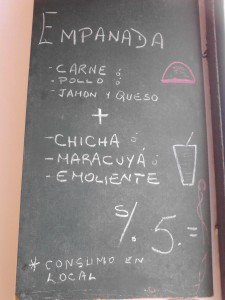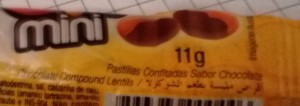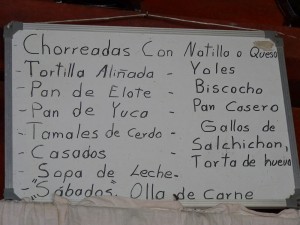What you need to know about marketing translations
One of the areas where my clients often need support when exporting to Latin America is translations. Although I speak fluent Spanish and English, I am not a translator and I rely on the incredibly hard and skilled work of translators.
If you are translating materials for your expansion into Latin America, that’s quite an achievement in itself and you should give yourself a pat on the back. It shows your commitment, sets you apart from your competition, and it will make your marketing process much smoother.

“Emoliente?” I took this picture in Lima. Not everyone in Latin America drinks “emolientes”, I tell you!
So here are some tips to make your life easier…
1- There is no such thing as “Latin American Spanish”
Sorry, but it’s true.
Do not expect a “Latin American Spanish” translation to fit every Latin American export market. You can get fairly close, but never, ever 100% there. Even in technical translations, the amount of variation can range from subtle to pretty huge.
What you are probably trying to achieve is something “distinctively different from mainland Spain that we can get away with from Mexico down to the South of Chile and Argentina, something that sounds that we are leaping out of Europe and taking Latin America seriously”.
2- Make sure the translation is fit for purpose.
I am talking here particularly about marketing materials. I have seen catalogues, websites, product packaging, etc translated technically very well (in terms of grammar, vocabulary, etc) but lacking colour, charm, well, marketing calibre. I was reading today a smarties package from Brazil translated into English as “chocolate compound lentils”. Ok, technically right but, who would like to actually buy that?

Chocolate compound lentils. Smarties, basically.
I write press releases and blog posts for exporters and when I do, I write the article from scratch in English and in Spanish. I don’t translate one into the other, because there is a lot more value in generating the content thinking like a native speaker of each language. But I know you can’t do that every time (I personally can’t, or that’s all I would ever do!).

According to this puzzle box, you could drown in it.
I find that copywriters are in very short supply in Latin America and translators can’t fill this void. Can you expect a translator to “translate” the marketing message rather than the actual words? I have asked an international translator based in Uruguay, Carmen Gahn, who explains:
“It is much harder to translate for marketing content than it is for generic informational or technical content because marketing writers often use figures of speech, cultural references and a shared knowledge that may not fare well with direct translation. When translating marketing content, you want to move beyond a straight or literal to a more conceptual translation or even adaptation or transcreation. The goal here is not to convey the words but a message that will have an impact as close to the original as possible. A good translation feels like it was written in the target language in the first place and provides maximum impact for marketing content. That way the resulting copy may look quite different in a literal sense, but it will say the same thing to its audience and convey the intended nuance in a way that is in line with brand character and local sensitivities”.
Well put.
3- Ask for a second opinion. And a third.
Needless to say, you should work with a translator or a group of translators that you trust. However, it doesn’t harm asking for a second opinion. I do that all the time for clients (and former clients) and I ask for second opinions myself: from sector experts, local partners and anyone who can have a skilled yet different view.
You could take this to the nth level, so when do you stop? I try to keep it proportionate to the translation investment and its longevity. If this is a £20k website translation to last two years, let’s dig properly. If it’s a £50 blog post translation to test a market, let’s keep the iterations to a minimum. And, as I said, focus on key markets. If the translation fits Colombia and that’s what you’re interested in, you can live with it if it doesn’t suit Bolivia perfectly. Return on investment is key not to paralyse business progress.

I’m a native Spanish speaker and I don’t understand at least half of this Costa Rican menu. I was lucky that our distributor translated for me…
4- Proof-read
Good translators will have a proof-reader in their team. However, ultimately, what goes out there is your responsibility. If a potential client questions your catalogue’s wording, it will look unprofessional and weak to blame every mistake on the translator. It’s your business, it’s your responsibility to get it right – to QA properly and to hire the best translators.
5- Go for it.
After you’ve done everything else, just go for it. You don’t need a perfect translation, you will never actually get one. You need one sufficiently good to achieve your ultimate aim: selling. Everything you translate is just a tool, not an end in itself.
